This 88-footer has been making waves on opposite sides of the world, coming 3rd in the 2015 Rolex Sydney-Hobart race. Crosbie Lorimer had a closer look in Hobart
“Will I bring Rambler 88 back next year? It’s too soon to be sure, but it’s certainly a possibilty.” The words of owner George David moments after crossing the finish line in 3rd position in the 2015 Rolex Sydney Hobart Yacht Race – and four minutes behind Syd Fischer’s 100ft Ragamuffin 100 – say as much about the nature and further potential of his yacht as they do about the draw of this classic ocean race.
Many have queried David’s choice of an 88-footer since her launch in December 2014 – too large for a Mini Maxi, too small to beat line honours 100-footers – but 12 months of impressive results seem to vindicate his choice. Indeed, it was largely only the fickle nature of the weather in the last day of racing that put paid to Rambler’s chances of an overall handicap win in Hobart.
So, what is so extraordinary about this yacht?
At first pass many of the features in evidence above the waterline reflect the design philosophy adopted by Juan K Design for its Open 60 and Volvo 70 projects: wide beam aft, sharply chined topsides forward, rounded stem, full length hull/deck chamfers, toed-in daggerboards, slight reverse sheer and a large foretriangle.

The topside chine forward deflects spray. The slightly arced and softer form of the chine can be seen abaft the daggerboards
But a closer look above and below the waterline reveals some new details, one of the more subtle of which can be found in the full length chine in the topsides. The sharp chine at the bow softens and rises in a very shallow arc in its central section to increase lateral wetted area and minimise waterline dissymmetry when heeling.
Replicating a humpback whale
Substantially less subtle are the striking orange twin rudders that have garnered much attention for their leading edge ‘nodules’, reportedly designed to replicate the hydrodynamic qualities of the tubercles on the pectoral fins of humpback whales.
Below decks is perhaps where many of the most innovative features of this yacht are to be found and not least in her systems design. With weight saving being the Holy Grail for all yacht designers and builders – and particularly for yachts with powered hydraulics – critical balances have to be struck between engine weight, fuel loads and power demand.
The design team chose a Steyr marine engine for Rambler as these powerful units are light and very fuel-efficient. However, that lightness by its very nature means less rotational mass than a heavier engine and thus a greater potential to stall under high power demand manoeuvres such as in gybing.
Rambler’s full-time boat engineer Brian Giorgio has spent many hours with systems engineers Kinetic Scientific and hydraulics specialist Central Coast Hydraulics refining the systems programming to minimise such incidences – “you learn to work within the capability of the engine, so having a control system like this allows you to fine tune it to an exhaustive point.”
In the same vein weight saving in wiring has significant upsides for performance. Rewiring the boat to aircraft grade specification has saved up to 50kg in weight, a seemingly insignificant figure for a yacht of nearly 23 tonnes perhaps, but a similar exercise on Comanche has lowered the centre of effort in the sail plan by 200mm.
The experience of Rambler 100’s keel failure and capsize in the 2011 Rolex Fastnet Race led owner George David to take a particular interest in keel performance. Consequently, Rambler 88’s keel operations are continuously monitored through a sensor on the pin and fibre optic patches on the fin; data is continuously logged and a dedicated read out in the navigation station provides real time feedback on bulb loads.
With another full year of racing ahead in which to hone her potential yet further, including summer regattas in the Mediterranean, there may be a number of Hobart contestants hoping that Rambler 88 will not be heading Down Under again in 2016.
Rambler 88 results 2015
Voiles de St Barths – overall winner
RORC Caribbean 600 – line honours winner (3rd overall)
Rolex Middle Sea Race – line honours winner (7th overall)
Rolex Sydney-Hobart – 3rd over line
Details

The twin rudders feature ‘nodules’ that reduce separated laminar flow when the rudder angle of attack increases. This reportedly also reduces drag on the tip

A 20cm hull concavity around the keel pivot point and the keel fin lengthened by the same amount adds a 15cm lateral offset to the bulb at 40° of rotation

The mainsail outhaul is controlled by an extending ram at the gooseneck. The boom also rotates to match the sail shape, reducing the loading at the tack

The H5000 series B&G readouts feature lit digits as well as backgrounds for improved night time visibility. Keel controls are by Kinetic Scientific
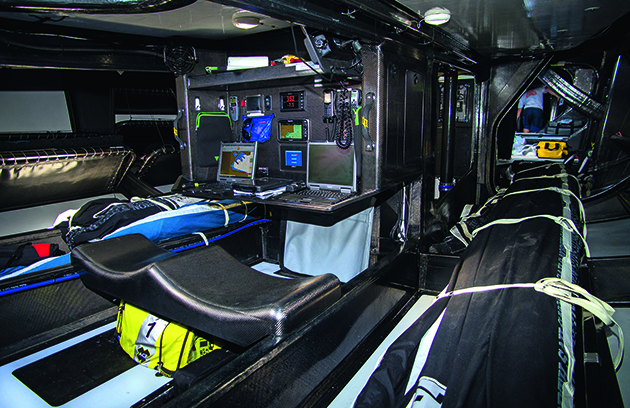
The navigation station sits abaft the systems bay below with an access and communications hatch parallel to the helmsman’s position

A dedicated keel monitoring readout is located in the navigation station and provides real time data as well as logging performance for future analysis
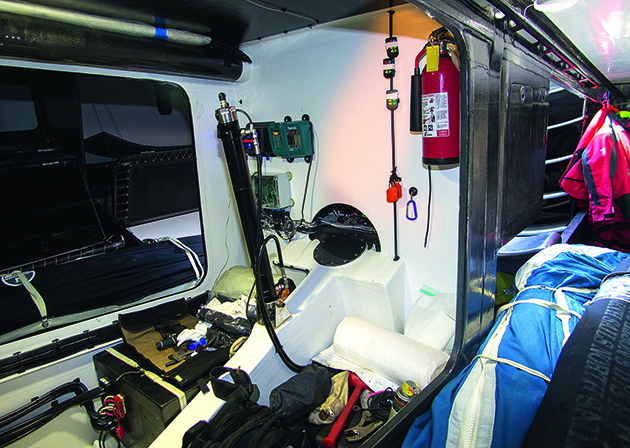
The engine prop is lowered and raised with a ram. When it is raised a trap door seals the hull and the controls self-monitor the propeller position when sailing
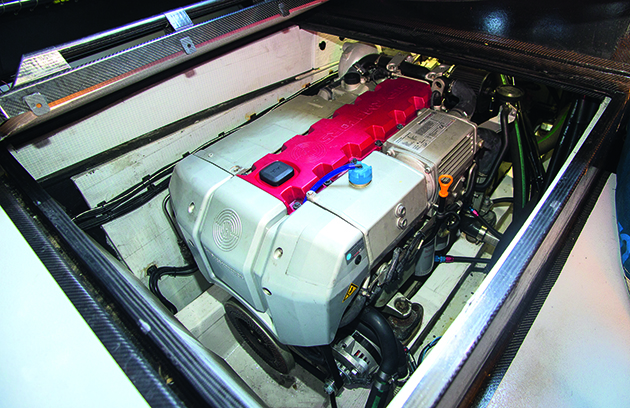
The Steyr marine diesel engine, located at the base of the companionway, has already clocked 2,000 operational hours in its first year
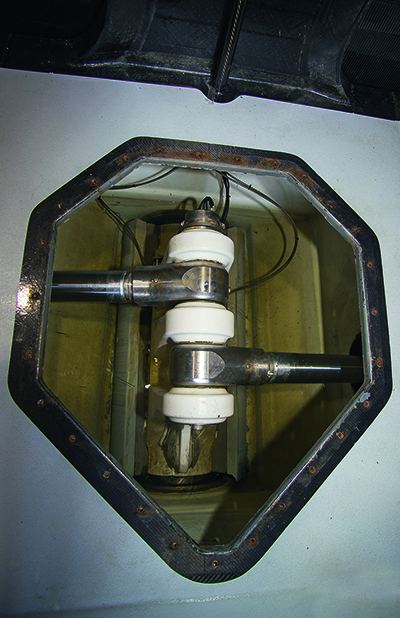
All keel elements are visually inspected after each race, while a pin sensor (top of picture) and fibre optic patches on the fin monitor loads and stresses
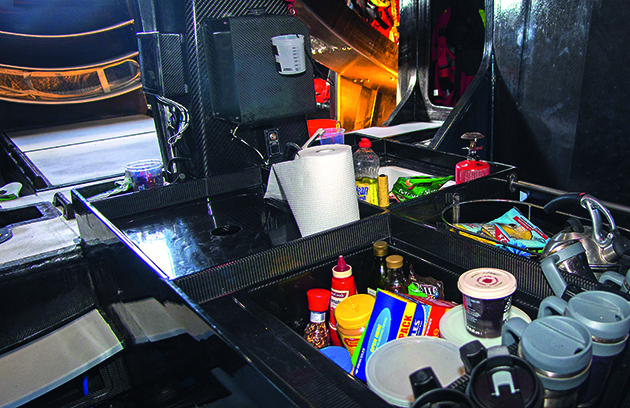
The small galley features an electronic water heater (mounted on the bulkhead) which provides boiling water more safely and quickly for all crew
Dimensions
LOA 27.00m/88ft 7in
Beam 7.10m/23ft 4in
Draught 6.00m/19ft 8in
Mast height 41.47m/135ft 10in
Displacement
(lightship) 22,890kg/50,463lb
Sail area:
upwind 512/638m2/5,511/6,687ft2
downwind 980m2/10,548ft2
mainsail 318m2/4,423ft2
IRC rating 1.88
Designed by Juan Kouyoumdjian Yacht Design
Built by New England Boatworks, RI, USA
Mast/boom Southern Spars
Sails North
Electronic systems Diverse Med, Kinetic Scientific
Keel hydraulics Central Coast Hydraulics
Control hydraulics Navtec, Cariboni, Harken
Foils Core Composites (daggerboards), New England Boatworks (rudders), Sydney Composite (sideboards)
Standing Rigging Southern composite rigging
Winch System Harken (primaries, 1100 Series)
Instruments B&G




